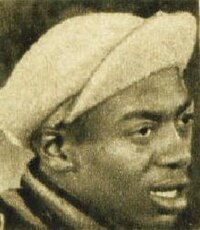Willie Best
| Willie Best | |
|---|---|

Best in a photo from Film Star Who's Who (1938)
|
|
| Born |
William Best May 27, 1916 Sunflower, Mississippi, U.S. |
| Died | February 27, 1962 (aged 45) Woodland Hills, Los Angeles, California, U.S. |
| Cause of death | Cancer |
| Resting place | Valhalla Memorial Park Cemetery |
| Other names | Sleep 'n' Eat |
| Occupation | Actor |
| Years active | 1930–1955 |
William "Willie" Best (May 27, 1916 – February 27, 1962), sometimes known as Sleep n' Eat, was an American television and film actor.
Best was one of the first African-American film actors and comedians to become well known. In the 21st century, his work, like that of Stepin Fetchit, is sometimes reviled because he was often called upon to play stereotypically lazy, illiterate, and/or simple-minded characters in films. Of the 124 films he appeared in, he received screen credit in at least 77, an unusual feat for a bit player.
A native of Sunflower, Mississippi, Best reached Hollywood as a chauffeur for a vacationing couple. He decided to stay in the region and began his performing career with a traveling show in southern California. He was regularly hired as a character actor in Hollywood films after a talent scout discovered him on stage.
Best appeared in more than one hundred films of the 1930s and 1940s. Although several sources state that for years he was billed only as "Sleep n’ Eat," Best received credit under this moniker instead of his real name in only six movies: his first film as a bit player (Harold Lloyd’s Feet First) and his next five films (Up Pops the Devil (1931), The Monster Walks (1932), Kentucky Kernels and West of the Pecos (both 1934), and Murder on a Honeymoon (1935)). He thereafter usually received credit as "Willie Best" or "William Best."
Best was alternately loved as a great clown, then later in the 20th century reviled and pitied, before being virtually forgotten in the passage of time. Hal Roach called him one of the greatest talents he had ever met. Similarly, comedian Bob Hope acclaimed Best as "the best actor I know," while the two were working together in 1940 on The Ghost Breakers.
As a bit player, Best, like many black actors of his era, was regularly cast in domestic worker or service-oriented roles (a few times he played the role that echoed his previous occupation—that of a private chauffeur). He often was seen making a brief comedic turn as a hotel, airline or train porter, but also as an elevator operator, custodian, butler, valet, waiter, deliverymen—and at least once as a launch pilot (in 1939’s Mr. Moto in Danger Island).
...
Wikipedia
